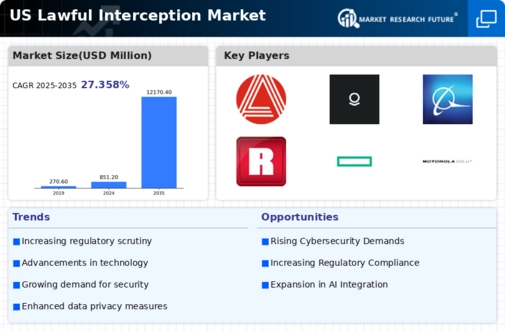The US Lawful Interception Market is characterized by a sophisticated landscape driven by various regulatory requirements and the technological needs of public safety. This market has gained considerable traction due to the increasing demand for surveillance and data collection capabilities to assist law enforcement agencies and national security organizations. As technologies evolve, so do the solutions offered by market players, which range from telecommunications providers to specialized software companies. Emerging threats and cybercrimes have heightened attention toward lawful interception, compelling providers to innovate and expand their service offerings while ensuring compliance with legal standards and privacy concerns.
Consequently, the competitive dynamics of this market involve ongoing collaborations, developments of niche technologies, and adaptability to regulatory changes, which shape the strategies of key market participants as they strive to capture market share while addressing the pressing demands of security and privacy. Avaya has established a notable presence in the US Lawful Interception Market through its comprehensive communication solutions that integrate advanced technologies catering to public and private sector needs alike. The company’s strengths lie in its robust portfolio that encompasses unified communications, contact center solutions, and customizable software platforms designed to support lawful interception mandates.
Avaya’s technological infrastructure allows for seamless integration with various telecommunication systems, making it a preferred choice for law enforcement and government agencies seeking reliable interception tools. The company emphasizes security in communication, which translates into a competitive advantage, enabling it to build strong relationships with its clients. Avaya’s innovation in creating user-friendly interfaces and its focus on meeting regulatory compliance further solidify its standing in the US market, ensuring that clients receive not only effective but also responsible interception solutions.
Palantir Technologies operates within the US Lawful Interception Market with a focus on data integration and analysis solutions that aid intelligence and defense agencies in their interception needs. Their flagship products, such as Palantir Gotham, provide powerful functionalities that allow users to visualize and analyze vast amounts of intercepted data. With a strong emphasis on partnership and collaboration, Palantir has worked with various governmental organizations, enhancing its reputation as a key player in ensuring national security through technology. The company’s strengths stem from its ability to handle complex datasets with ease, supporting law enforcement in data-driven decision-making processes.
Recently, Palantir has expanded its footprint through strategic mergers and acquisitions, further enhancing its technological capabilities. This positions the company favorably to address evolving requirements for lawful interception, ensuring that it remains at the forefront of innovative solutions while continuing to lead in this crucial domain in the US market.























Leave a Comment